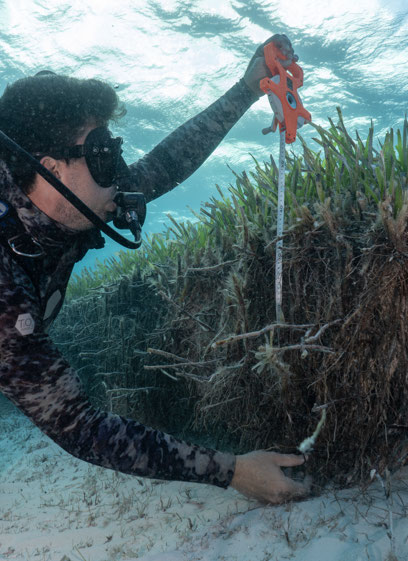Blue
Natural Capital
![]()
Blue Carbon
Climate Resiliency
Our oceans and our climate are tightly linked with both experiencing unprecedented changes that risk the stability of our planet for future generations. Blue Carbon is a term that describes all of the carbon dioxide that is pulled out of the earth’s atmosphere and stored in marine ecosystems. As part of its ongoing efforts to discover, conserve and protect the ocean, BTW recognizes the benefit of focusing scientific resources on threatened Blue Carbon ecosystems in order to create an even bigger impact: not just for the ocean, but the future of our own species in the fight against climate change.
Through studying tiger sharks in The Bahamas, BTW found the largest seagrass meadow on earth – an estimated 90,000 km2 – and one of the planet’s most significant Blue Carbon spaces. Partnering with SeaLegacy, our teams seek to raise awareness about the value and importance of the seagrass meadow of the Bahama Banks:
Through this research, we have also discovered that Blue Carbon ecosystems are far more efficient at sequestering carbon than land-based ecosystems and trap carbon for centuries. When these locations are damaged or disturbed, all of the carbon that was sequestered in marine sediment is released back into the environment, exacerbating the impacts of climate change. The most common Blue Carbon ecosystems worldwide are salt marshes, mangrove forests, seagrass meadows, and kelp beds.



Images by Shane Gross and Cristina Mittermeier.
Beneath The Waves is actively involved in Blue Carbon research projects across the Caribbean, encompassing one of the planet’s most significant areas of resilience ever surveyed. Spanning seagrass meadows, mangrove forests, estuaries, and shallow sandbanks, our project sites are also home to some of the most threatened marine species on earth, such as tiger sharks and sea turtles. Beneath The Waves is working to protect these carbon-rich banks, and our ocean’s regulatory systems so that these nursery grounds can continue to sequester carbon from the atmosphere and fight climate change. New advances and discoveries by our team are allowing Blue Carbon to become a nature-based solution that actively protects biodiversity and vital parts of our ocean. If we are to successfully combat the threat of climate change, we must look to the solutions that blue natural capital has provided. We will continue to study the ongoing processes within our ocean’s systems with wonder and an instilled hope for a better relationship with our planet. This partnership with nature requires our vigilant protection and active support of the inherent solutions that healthy ocean ecosystems provide.


Impact
This project will drive impact in the following ways:
- Foster the protection of Blue Carbon hotspots and ecosystem services indefinitely through small and large-scale marine protected area designations
- Leading a major upward revision of assessed oceanic Blue Carbon stocks
- Provide 100+ years of renewable revenue to local governments, citizens, and stakeholders in climate-threatened regions
- Further document and understand the interaction between threatened marine megafauna and Blue Carbon ecosystems
- Mitigate future impacts of climate change by protecting Blue Carbon ecosystems and carbonate banks by helping countries achieve carbon neutrality and build local capacity










